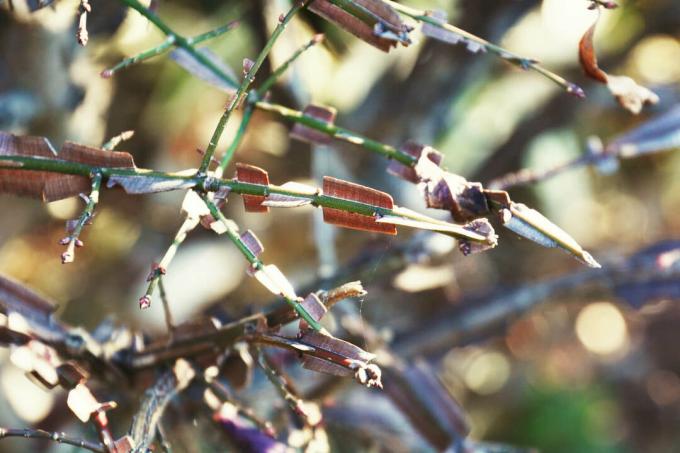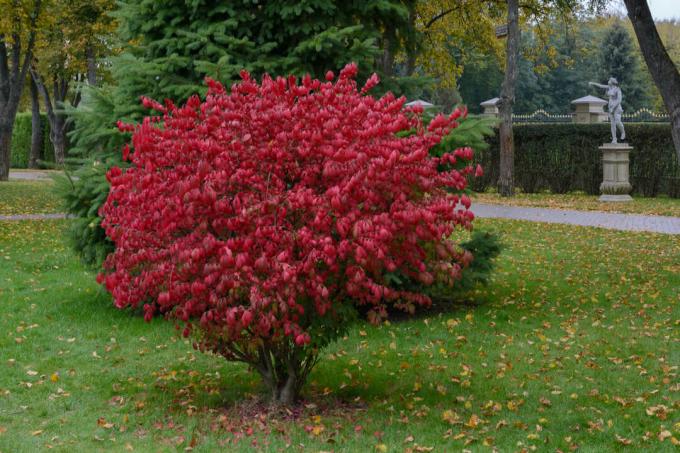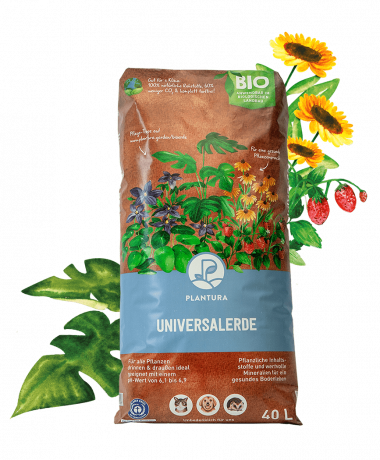The deep red autumn color makes the hardy and easy-care corkwing shrub a real eye-catcher, even in cities.

corkwing bushes (Euonymus alatus) can be used in a variety of ways in the garden, for example as deciduous hedges with a wow effect in autumn or as robust and easy-care ornamental shrubs in the front yard. In this article you will learn all about growing and caring for the winged spindle tree. We will also introduce you to some varieties and answer the question of whether the cork wing bush is poisonous.
Contents
- Corkwing shrub: origin and properties
- The Best Varieties of the Winged Spindle
- Plant corkwing bush
- Corkwing shrub: The most important care measures
- Is Euonymus alatus poisonous?
Corkwing shrub: origin and properties
Euonymus alatus is known to us by many names. These range from corkwing or winged spindle tree and cork spindle to winged spindle tree. The words cork or wings appear in many of the names, which indicates a special property of these
euonymus-Art indicates. The bark of cork winged shrubs is characterized by the fact that four cork strips protrude like small wings on the green, angular branches. Originally originated Euonymus alatus from the East Asian region. Since the cork wing shrub is relatively undemanding in terms of location and can tolerate temperatures down to -34 °C, it can also be planted here without any problems. With a final height of about 2 to 3 meters and about the same width, the rather slow but sprawling shrub is ideal as a solitary tree in the garden or at the edges of ponds. Its roots are shallow and very finely branched. The corkwing bush endures a cut without complaint and willingly drives out again and again if it is sufficiently supplied with water. It is considered a good city tree because it can easily handle warm air, road salt and smoke.
The most well-known highlight of the cork spindle is certainly its foliage. If it is still green and rather inconspicuous during the summer, it turns from fiery red to pink or violet in autumn, depending on the variety and location, making it a real eye-catcher. This is how the English trivial name "Burning Bush" can be explained. The flowers of the cork wing bush, on the other hand, are rather inconspicuous. They are small, yellow-green and only seen between May and June. In return, striking red-orange capsule fruits develop from them, which remain on the bush throughout the winter and are eaten by birds as winter food. The fruits can also be extremely tempting for us humans - but you shouldn't taste them because they are poisonous for us.
Tip: Even though the winged spindle is poisonous to us humans and many animals, it should not be missing in animal-friendly gardens. In spring, the inconspicuous blossoms of Euonymus alatus insects and in autumn and winter the fruits provide food for many birds. Pets and other garden animals usually know exactly what they can eat and avoid the corkwing bush anyway.

The Best Varieties of the Winged Spindle
In many gardens, shrubs with a height and width of almost 3 meters hardly fit into them, no matter how good they look. For this reason, some significantly smaller varieties were bred. But even if you have a lot of space, you can look forward to some special varieties.
Euonymus alatus ‘Blade Runner’: 'Blade Runner' grows only slightly shorter than the species. But it stands out with its cork strips, which are up to 2 cm wide. These are particularly noticeable in winter when there are no leaves and make it a real eye-catcher even in the cold season.
Euonymus alatus ‘Fireball’: Here, too, the name says it all, because the growth of the 'Fireball' variety is spherical. The shrub grows up to 3 meters high and almost as wide. However, it only reaches these dimensions very slowly, since 'Fireball', like the species, only grows very slowly, at around 10 to 20 cm per year.
Euonymus alatus ‘Chicago Fire’: In terms of growth, 'Chicago Fire' hardly differs from the species, because it is about the same size and width. However, the variety is characterized by a particularly early onset and long-lasting autumn color.

Low Corkwing Shrub (Euonymus alatus 'compactus'): As the name suggests, the Corkwing shrub variety 'Compactus' remains significantly more compact than the species with a height of 1 to 1.5 meters and about the same width. Although not the smallest variety, this has earned it the nickname dwarf corkwing bush. This makes the low cork spindle shrub ideal for gardens with little space, but in which you still don't want to do without the unique autumn colors.
Euonymus alatus 'Little Moses': One of the smallest varieties of the corkwing bush is 'Little Moses'. The variety grows broad and plump, but reaches a maximum height of 80 - 100 cm. It can be grown well in containers on the terrace, balcony or in small gardens. Like all varieties of Euonymus alatus 'Little Moses' is also hardy here.

Plant corkwing bush
A suitable location for Euonymus alatus is sunny with well-drained, rather nutrient-rich soil. However, partial shade is also well tolerated. Very loamy or clayey soils should be treated, for example, by mixing in compost or our Plantura organic universal soil be improved. When choosing a location, it is important to ensure that it is evenly moist. The shallow root system is quickly damaged by drought, which is why little water is very badly tolerated in the long run. Basically, you can plant new plants all year round in the frost-free period. However, it is better if the planting takes place either in spring or in autumn. You can find out how to proceed when planting the cork wing bush in the article on the genus der Spindle bushes (euonymus) read. After planting, it is advisable to mulch around the shrub. This ensures more even moisture in the soil and thus protects the sensitive fine roots mentioned above. For example, sheep's wool, bark mulch or our particularly durable ones can be used for this Plantura organic pine bark.

Organic pine bark 60 L
- Pure & natural organic pine bark for mulching beds & paths
- Suppresses weeds & protects against soil erosion and drying out
- In a coarse structure from 25 to 40 mm - sustainably manufactured in the EU
Tip: The corkwing bush also thrives in shady locations, but the foliage there turns pink instead of red in autumn.

The corkwing bush can be propagated by seeds or cuttings. You can read more about propagation from cuttings in the general article Spindle bushes read. The propagation of the corkwing bush from seeds is not easy. With a bit of luck, however, a cork wing bush will grow by itself. You can then simply dig up the young plants and transplant them.
Tip: The cork spindle can be grown well in a pot. This should be rather wide to accommodate the shallow, spreading root system. Also, change the substrate every two to three years. We recommend a soil with a favorable ratio between air and water capacity, for example ours Plantura organic universal soil. This provides all the important nutrients and is also completely peat-free, which is why almost 60% less CO is produced in its production2 is emitted compared to conventional soils. There Euonymus alatus is very hardy, it does not need any special protection during the winter.

Organic universal soil 40 L
- Ideal for all plants in the house, garden and on the balcony
- Ensures a vital & strong plant splendor as well as a healthy soil life
- Peat-free & climate-friendly: CO2-reduced organic soil made in Germany
Corkwing shrub: The most important care measures
Euonymus alatus is considered to be easy to care for. Once it has grown well in a suitable location, it usually no longer needs to be watered. Only during long periods of drought, when it begins to droop, should one go to the Grab a watering can or, even better, a water hose and water the corkwing bush properly donate However, on barren soils that dry out more quickly, you cannot avoid regular watering, as the corkwing bush only has shallow roots.

One must Euonymus alatus do not cut. The shrub grows rather slowly and its natural growth form is reminiscent of an umbrella. If you still want to cut your wing spindle shrub, for example because it has grown too big, you can use pruning shears without hesitation. A topiary or hedge trimming is usually well tolerated by the cork wing bush. Another possibility is to grow the corkwing bush as a multi-stemmed standard. You don't have to pruning the corkwing bush either, but you can remove dead, dead wood. The best time to trim is late winter or early spring.
In rather nutrient-poor soils, caring for the corkwing bush can also include annual fertilization in spring. For example, our can be used for this Plantura organic universal fertilizer with long-term effects or some compost. However, considering the shallow root system, it is best not to work the fertilizer into the soil, but only distribute it under the mulch layer.

Organic universal fertilizer 1.5 kg
- Ideal for a variety of plants in the garden & on the balcony
- Supports healthy plant growth and active soil life
- Animal-free organic slow-release fertilizer - safe for pets and garden animals
from diseases Euonymus alatus only very rarely affected. Under unfavorable conditions it can happen that it is covered by powdery mildew (Blumeria graminis) or some types of rust fungus (Pucciniales spec.), which can be recognized by a white coating or red pustules. Most of the time, however, the corkwing bush copes well with these diseases and control is not necessary.
Occasionally, however, the shrub is plagued by pests. aphids (Aphidoidea) and especially some spider moth species (Yponomeutidae spec.) can be extremely annoying. Even if these two usually don't do much harm to the shrub and it will sprout again the following year at the latest, you can take action against them. tips for natural control of aphids can be found in a separate article. In the case of spider moths, infested branches should be removed and ideally disposed of in the household waste.

care at a glance
- With good soil, watering is only necessary during longer dry periods.
- Euonymus alatus does not need to be cut. However, a shape, pruning or recovery cut can be made in early spring before budding.
- Fertilization is also not absolutely necessary, but can be carried out on rather nutrient-poor soils in spring at the start of growth.
- The cork wing bush is usually spared from diseases. However, some pests such as spider moths can become a nuisance.
Is Euonymus alatus poisonous?
Like all euonymusspecies, the corkwing bush is also poisonous. This applies not only to us humans, but also to most pets and garden animals. Only birds are happy about the very poisonous seeds of Euonymus alatus. The symptoms of consumption can be varied and range from abdominal pain and nausea to kidney damage and circulatory problems. In very severe cases, consumption of the poisonous winged spindle tree could even lead to death.

If you are always impressed by the colors of some trees and shrubs in autumn, take a closer look at our special article on this topic. In this we introduce 10 more Shrubs and trees with intense autumn colors before.
Register now for the Garten-Post and receive great tips, seasonal trends and inspiration on everything to do with the garden from our expert every week.



